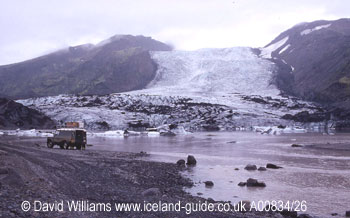 |
| This the author`s vehicle beside the Jökulsá. This is a different Landrover from the one described in the text but is similarly equipped. |
 |
| This
is the author fording the Krossá on the morning after the crossing
described in the text. The Iceland Safari bus is on the left. Note
the very wide gravel plain through which the river flows; the river
will frequently change its route through the gravel. Even though it
is morning, when the river level is low (!!), there is still a substantial
wall of water on the upstream side of the vehicle (on the right),
indicating just how dangerous the river is and how easily it can push
a vehicle downstream. This photograph was taken by Martin Thomas and he very kindly sent it to me. I have tried to contact Martin, but with no success. If anyone can help me contact him I would be very pleased. |
The valley
narrowed as we continued on the track. Two more difficult rivers were
crossed, the Steinholtsá and the Hvanná, but these crossings
were relatively uneventful. Then Stefan stopped and got out. There it
was: the Krossá. There weren`t big boulders in the river as in
Gígjökull, but you could hear the chilling, rattling sound
of the pebbles being carried downstream by the current of very cold water.
I now understood the Krossá`s hidden danger - its fast-moving bed
of rolling pebbles; I hadn`t come across this before and no-one had ever
mentioned it to me. I had had a minor problem with Gígjökull,
but this river was much wider and faster. And much more dangerous. And
many more spectators.
I stood there,
just gazing. In theory I should have crossed the river in the morning
when it would have been lower. But this was late afternoon on a warm summer`s
day and the glacier that fed the river would melt faster in these conditions
so dramatically increasing the volume of water gushing downhill. Just
my luck.
Stefan crossed
and waited. I composed myself and chose my entry and exit points. The
crossing started well and I made good progress. Then I felt the great
force of the water pushing me downstream. I felt I was losing grip on
the moving river bed. I kept the revs up and slipped the clutch, hoping
that the pressure of the exhaust gases would be sufficient to prevent
water flowing into the exhaust pipe. Getting towards midstream, I sensed
the water lapping around the bottom of the doors. I revved hard and slipped
the clutch, lest the engine stalled. Then, even though I was heading diagonally
downstream, water started coming over the Land Rover`s bonnet and running
menacingly towards the windscreen. Goodness knows what the depth of the
wall of water at the back of the vehicle was. I hadn`t time to think about
the consequences of failure; I just kept going for what seemed an age,
almost willing the vehicle forward. Gradually the water receded from the
bonnet and, without any warning, the front of the vehicle lurched upwards
as the wheels reached the bank. I was soon right out of the water. I cut
the engine and only then knew it was all over. In a state of shock I tried
to run over to Stefan to thank him but my legs were like jelly; indeed
my legs, my arms, the whole of my body was shaking. But, I`d done it.
And I`d kept the photographers happy.
| First page of this article |